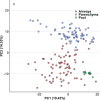Metabolomics of Lung Microdissections Reveals Region- and Sex-Specific Metabolic Effects of Acute Naphthalene Exposure in Mice
- PMID: 34498071
- PMCID: PMC8633889
- DOI: 10.1093/toxsci/kfab110
Metabolomics of Lung Microdissections Reveals Region- and Sex-Specific Metabolic Effects of Acute Naphthalene Exposure in Mice
Abstract
Naphthalene is a ubiquitous environmental contaminant produced by combustion of fossil fuels and is a primary constituent of both mainstream and side stream tobacco smoke. Naphthalene elicits region-specific toxicity in airway club cells through cytochrome P450 (P450)-mediated bioactivation, resulting in depletion of glutathione and subsequent cytotoxicity. Although effects of naphthalene in mice have been extensively studied, few experiments have characterized global metabolomic changes in the lung. In individual lung regions, we found metabolomic changes in microdissected mouse lung conducting airways and parenchyma obtained from animals sacrificed at 3 timepoints following naphthalene treatment. Data on 577 unique identified metabolites were acquired by accurate mass spectrometry-based assays focusing on lipidomics and nontargeted metabolomics of hydrophilic compounds. Statistical analyses revealed distinct metabolite profiles between the 2 lung regions. Additionally, the number and magnitude of statistically significant exposure-induced changes in metabolite abundance were different between airways and parenchyma for unsaturated lysophosphatidylcholines, dipeptides, purines, pyrimidines, and amino acids. Importantly, temporal changes were found to be highly distinct for male and female mice with males exhibiting predominant treatment-specific changes only at 2 h postexposure. In females, metabolomic changes persisted until 6 h postnaphthalene treatment, which may explain the previously characterized higher susceptibility of female mice to naphthalene toxicity. In both males and females, treatment-specific changes corresponding to lung remodeling, oxidative stress response, and DNA damage were observed. Overall, this study provides insights into potential mechanisms contributing to naphthalene toxicity and presents a novel approach for lung metabolomic analysis that distinguishes responses of major lung regions.
Keywords: lung; metabolomics; microdissection; polycyclic aromatic hydrocarbons.
© The Author(s) 2021. Published by Oxford University Press on behalf of the Society of Toxicology. All rights reserved. For permissions, please e-mail: journals.permissions@oup.com.
Figures






Similar articles
-
Relationship of cytochrome P450 activity to Clara cell cytotoxicity. IV. Metabolism of naphthalene and naphthalene oxide in microdissected airways from mice, rats, and hamsters.Mol Pharmacol. 1995 Jan;47(1):74-81. Mol Pharmacol. 1995. PMID: 7838135
-
NMR- and MS-based metabolomics: various organ responses following naphthalene intervention.Mol Biosyst. 2014 Jul;10(7):1918-31. doi: 10.1039/c4mb00090k. Epub 2014 May 7. Mol Biosyst. 2014. PMID: 24802150
-
Cellular and metabolic basis of Clara cell tolerance to multiple doses of cytochrome P450-activated cytotoxicants. I: Bronchiolar epithelial reorganization and expression of cytochrome P450 monooxygenases in mice exposed to multiple doses of naphthalene.J Pharmacol Exp Ther. 1996 Sep;278(3):1408-18. J Pharmacol Exp Ther. 1996. PMID: 8819528
-
Mouse specific lung tumors from CYP2F2-mediated cytotoxic metabolism: an endpoint/toxic response where data from multiple chemicals converge to support a mode of action.Regul Toxicol Pharmacol. 2009 Nov;55(2):205-18. doi: 10.1016/j.yrtph.2009.07.002. Epub 2009 Jul 7. Regul Toxicol Pharmacol. 2009. PMID: 19589367 Review.
-
Genetic toxicity of naphthalene: a review.J Toxicol Environ Health B Crit Rev. 2003 Mar-Apr;6(2):161-83. doi: 10.1080/10937400306472. J Toxicol Environ Health B Crit Rev. 2003. PMID: 12554433 Review.
Cited by
-
Pulmonary Fibrosis as a Result of Acute Lung Inflammation: Molecular Mechanisms, Relevant In Vivo Models, Prognostic and Therapeutic Approaches.Int J Mol Sci. 2022 Nov 29;23(23):14959. doi: 10.3390/ijms232314959. Int J Mol Sci. 2022. PMID: 36499287 Free PMC article. Review.
-
Involvement of naïve T cells in the pathogenesis of osimertinib-induced pneumonitis.Sci Rep. 2025 Mar 27;15(1):10545. doi: 10.1038/s41598-025-95271-9. Sci Rep. 2025. PMID: 40148432 Free PMC article.
-
Klotho Regulates Club Cell Senescence and Differentiation in Chronic Obstructive Pulmonary Disease.Cell Prolif. 2025 Jul;58(7):e70000. doi: 10.1111/cpr.70000. Epub 2025 Feb 10. Cell Prolif. 2025. PMID: 39930762 Free PMC article.
-
Alteration of glycosphingolipid metabolism by ozone is associated with exacerbation of allergic asthma characteristics in mice.Toxicol Sci. 2023 Jan 31;191(1):79-89. doi: 10.1093/toxsci/kfac117. Toxicol Sci. 2023. PMID: 36331340 Free PMC article.
References
-
- Bradley H., Nccoxnell S. D., Crystal R. G. (1974). Lung collagen composition and synthesis. J. Biol. Chem. 219, 2674–2683. - PubMed
-
- Brunetti M., Gaiti A., Porcellati G. (1979). Synthesis of phosphatidylcholine and phosphatidylethanolamine at different ages in the rat brain in vitro. Lipids 14, 925–931. - PubMed

